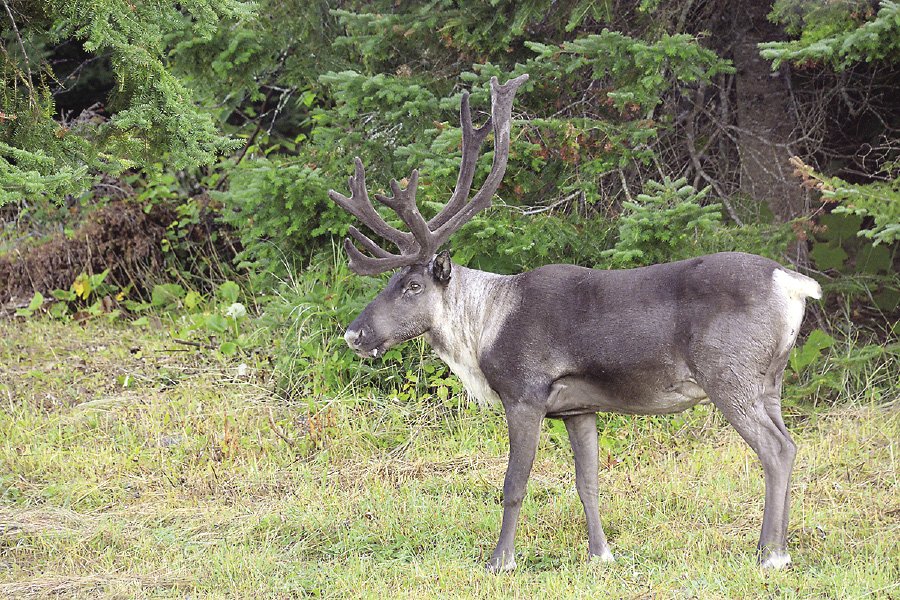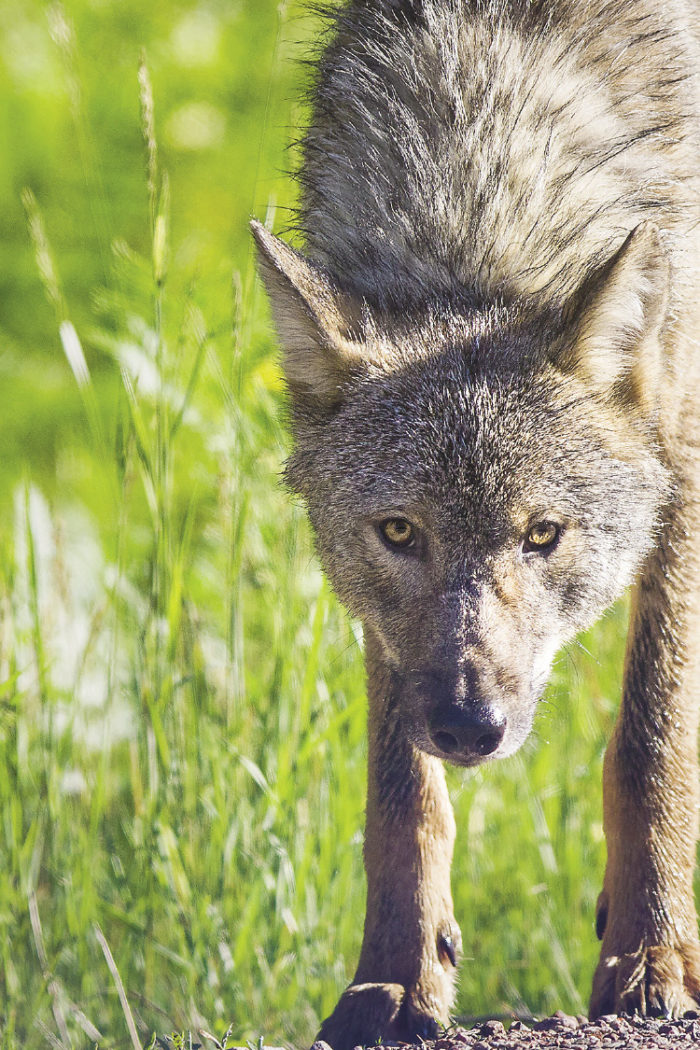The Northern Wilds is a place where you can happen upon a bull moose on a morning paddle or listen to the serenade of a wolf pack on an otherwise silent winter night. A lucky few have had the good fortune to see woodland caribou somewhere on the rugged Ontario shore. While these three wildlife species are the essence of the North, we can’t take their continued existence for granted. In Minnesota, wolves have been protected under the federal Endangered Species Act nearly continuously since the 1970s. An alarming decline began in Minnesota and adjacent Ontario moose populations in the early 2000s. More recently, woodland caribou nearly disappeared from the North Shore until they were saved by a last-ditch translocation effort. We spoke with wildlife experts to learn how well each species is doing now.
Minnesota moose numbers stabilize
Northeastern Minnesota has far fewer moose than it did 20 years ago, but the population appears to have stabilized during the last five or six years at 3,000-4,000 animals.
“The numbers bounce around from year to year, but the population appears to be stable,” said Mike Schrage, wildlife biologist for the Fond du Lac Band of Ojibwe. “That could change in the future—either up or down.”
Why moose stopped declining in numbers is a matter of conjecture, but multiple factors are likely at play. Beginning with the winter of 2013-14, the moose range has had a series of moderate to severe winters which significantly reduced the deer population. That in turn may have lessened the prevalence of the parasitic brain worm that is indirectly transmitted from deer to moose. The brain worm does not affect deer, but is often fatal to moose. The lack of deer likely has reduced the region’s wolf numbers as well, lessening predation on moose. Deep snows that have stubbornly lingered into spring may have helped, too. The winter ticks that infest moose and fall off them in the early spring have poor survival when deep snow covers the ground.
In addition to less predators and parasites, moose may have had more habitat. Large forest disturbances created by wildfires and timber harvest provides the new growth moose prefer. Biologists are seeing good numbers of moose in Ham Lake and Pagami Creek burns.
“Whether that is enough to stabilize the population we don’t know, but it is good for moose where it exists,” Schrage said.
What biologists haven’t seen in recent years was an increase in the number of calves counted in the annual aerial survey conducted every January. Schrage said it is possible that aforementioned factors improved the survival of adult moose.
Due to the population decline, the state and three Ojibwe bands with treaty rights within the Arrowhead, ceased moose hunting in 2013. The tribes resumed moose hunting in 2016, stating their relatively small harvest of bulls does not affect the overall population. When interviewed in mid-November, Schrage said Fond du Lac hunters registered 21 bulls, short of the season’s quota of 24. Morgan Swingen, wildlife biologist for the 1854 Authority said Grand Portage harvested two bulls and Bois Forte had taken one.
Lake Superior caribou hang on
Woodland caribou continue to persist along Lake Superior’s North Shore in Ontario and conservationists are hopeful the population may recover to sustainable levels. The population was at the brink of
extinction in 2018 when wolves threatened to wipe out the population on Michipicoten Island. A group of conservationists and Michipicoten First Nation intervened and 10 (nine survived) caribou were translocated from there to the Slate Islands and six to Caribou Island. The Slates previously had a caribou population that was functionally extirpated by wolves in 2017.

Islands serve as refuges where caribou avoid wolf predation. In the case of both Michipicoten and the Slate Islands, wolves crossed on the ice when Superior froze during the unusually cold winter of 2014. While the Slates are now wolf-free, Leo Lepiano, conservationist and consultant to Michipicoten First Nation in Wawa, says two wolves remain on Michipicoten Island. Since the island is now devoid of caribou, and the beaver population has been greatly reduced, the wolves may not survive the winter. Eight wolves there were captured last winter and moved to Isle Royale National Park as part of an ongoing wolf stocking program.
Once wolves are gone from the island, caribou will be reintroduced. Micipicoten is large enough to support at least 800 caribou without affecting the habitat or leading to a decline in condition of the caribou, Lepiano said. He hopes that it will eventually serve as a source of caribou for further restoration along the North Shore.
On the mainland shores, only a handful of caribou remain. An aerial survey last winter found three locations between Marathon and Schreiber where caribou tracks were seen, but there were likely no more than a few animals in any location. In Pukaskwa National Park, caribou have not been seen since 2012, and were deemed officially extirpated in 2017.
Unbeknownst to the caribou, they are political animals in Ontario. They are especially sensitive to human activities such as logging and mining, which disrupt habitat and migration corridors, as well as altering the landscape in ways that allow moose and white-tailed deer to proliferate. This in turn increases wolf densities, resulting in increased predation on caribou, which are easier targets than the larger moose. In addition, deer carry a brain worm that doesn’t affect them, but is often fatal to caribou.
Ontario caribou management calls for setting aside undeveloped migration corridors so Lake Superior caribou can reach existing populations further to the north. This is why they are political animals, because mining and forestry underpin the northern economy. Local interests, including at least one First Nation, object to the economic constraints posed by the corridors. Lepiano is hopeful a compromise can be worked out.
Currently, Lepiano and other caribou advocates are meeting with various government agencies and officials to build support for a Lake Superior caribou recovery. Eventually, caribou might be found on the North Shore from Lake Superior Provincial Park westward to the Rossport Islands.
Wolf population stays steady
Minnesota’s gray wolf population remains stable, as it has been for about two decades, says Dan Stark, large carnivore specialist with the Minnesota DNR. Annual fluctuations in wolf numbers largely correlates with forest deer abundance. When deer numbers rise, so do the numbers of wolves.

The DNR conducts a midwinter wolf population survey to derive a population estimate. For the 2017-18 winter the estimate was 2,699 animals, with a confidence interval of plus or minus 700. The survey began in the late 70s at 10-year intervals, later was done at five-year intervals and has been conducted annually since 2012. The survey includes the DNR’s field efforts, as well as input from other entities in the state that monitor wolves, such as the federal research project initiated by biologist Dave Mech, research in Voyageurs National Park and tribal natural resource programs.
The survey gives wildlife managers some insight into the world of Minnesota wolves. The average territory for a pack is 40 to 60 square miles, based on the abundance of deer and other prey. In some places, a pack territory may be as little as 10 square miles or up to 200 square miles in deer-poor regions of the north. A typical pack contains four to five wolves. Stark said while hunters sometimes say there are “wolves everywhere,” the animals tend to move around their territory. They do frequent core areas within their territory for denning or to rendezvous with the rest of the pack.
Starks says wolves occupy all of the suitable range in the state, and are unlikely to expand. Some packs on the southern and western fringe of the range live in areas where agriculture and other human land uses fragment the habitat. A pack has been established in southern Isanti and northern Anoka counties, disconnected from the core wolf range. Although the pack has produced a couple of litters, whether it persists over time depends on the tolerance of and possible conflicts with people.
Presently, wolves are protected in Minnesota under the federal Endangered Species Act. They were briefly taken off the list three times: March 2007-September 2008, May-June 2009 and January 2012-December 2014. During the latter period, Minnesota conducted wolf hunting/trapping seasons in 2012, 13 and 14. Although wolf delisting is contentious, the state population has been well above federal recovery goals for decades.
“Our (DNR) point of view is that wolves have recovered,” said Stark. “We have been monitoring the population and are prepared to manage them.”
To that end, the agency is looking to update its wolf plan, which was adopted in 2001.
Gray wolves occupy all of the suitable habitat for the species in Minnesota.




